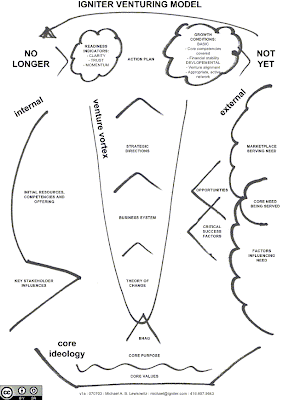I've been wanting to post on this for a while now. It's a snapshot of my latest understanding of the venturing process. It's early draft and the writing below is pretty much stream of consciousness but I'm being drawn to just get it out:
We're in an interesting point in history where there is a transition from a mindset based on seeking to understand the smallest components of things (reductionist thinking, command and control models, 'the great clockwork', world/problems as 'complicated') toward a mindset that looks at systems in terms of the relationships/context in order to understand them (systems, ecological, 'complex').
I've been finding the early-stage venturing process as an interesting place to explore this transition and what it means for those who are using venturing as an approach to addressing issues that are becoming increasingly important to people and the planet.
Where I've come to is a visual model that helps me understand the forces at play in using a venturing as a tool to move things from one place to another, from one system to the envisioned system, from the no longer to the not yet.
I consider venturing as a vortex... a complex phenomenon that excels when it finds itself in a stable state far from equilibrium. In other words when it's functionally stable on the edge of big changes in a marketplace.
There are 3 major contributing forces/dynamics that shape the vortex: internalities, externalities, and ideology. The conditions that lead to the creation of the vortex can be described as the trio of clarity, trust, and momentum. The conditions that then sustain, strengthen and accelerate the vortex are the conditions of basic financial stability, core competency coverage, the alignment of the vortex itself internally and within the 3 dynamic forces, and finally the availability of an appropriate, active network.
Moving into the vortex moves is where the process of rationalization enters. It is the balancing act of moving from core ideology (which describes the plane that the venture is being asked to operate in) to the theory of change (a rationalization of what you believe needs to be changed for the system to change --- for your big, hairy audacious goal to be achieved), to the business system which translates the theory into a functional operational model that will perform the functions and deliver the services necessary to act on that theory of change. From there the more conventional strategic planning approaches enter in informing areas of activity that will most likely result in the organization moving toward the BHAG. Finally come the set of actions (action plan) that the organization is actually doing which are hoped to contribute to achieving the goal.
Conventional business school education has focussed on developing theories based on employing a command and control approach to moving organizations operating more closely toward equilibrium, which naturally is also where financial resources are most greatly employed. The farther from equilibrium something is... the harder it is for command and control approaches to work with predictable effectiveness. The proxy then in the capital markets has then naturally become the trust of the entrepreneur/management and the angel community which are not burdened by the same fiduciary duty that fund managers have (which is consider best served by the tried and true command and control model).
It's not surprising then to see the emergence of 'social entrepreneurs' as the magically/mystically powerful icons they are becoming. In trying to tackle systemic shifts there is little in terms of approaches that are acknowledged as 'tried and true' because these shifts inherently are working at a place of being far from equilibrium and so are seen as 'complicated', 'risky', and inherently slippery when put under the conventional investment or reductionist rigor. Social entrepreneurs inherently are adept at intuiting their way through a complex endeavor and take on that responsibility internally. The trust in them to manage this is the proxy for the command and control model when it is recognize that conventional analysis and theory is too cumbersome, inconsistent, and unpredictable.
The attempt here then becomes one of unpacking what happens intuitively within the social entrepreneur and those advisers and contributors that have developed a good 'gut' for navigating a venture vortex from the no longer to the not yet. My hope with this is that we can begin to broaden the understanding of this complex process and thereby broaden society's ability to employ the venturing process to evoke the systemic shifts that are and are asking to unfold as part of the history we are creating.
Onward...
.: on the frontiers of venturing and venture investing :.
Friday, July 6, 2007
A Venturing Model
Posted by
Michael A. B. Lewkowitz
at
8:24 PM
![]()
Labels: complex, systemic intervention, venturing model
Subscribe to:
Post Comments (Atom)
